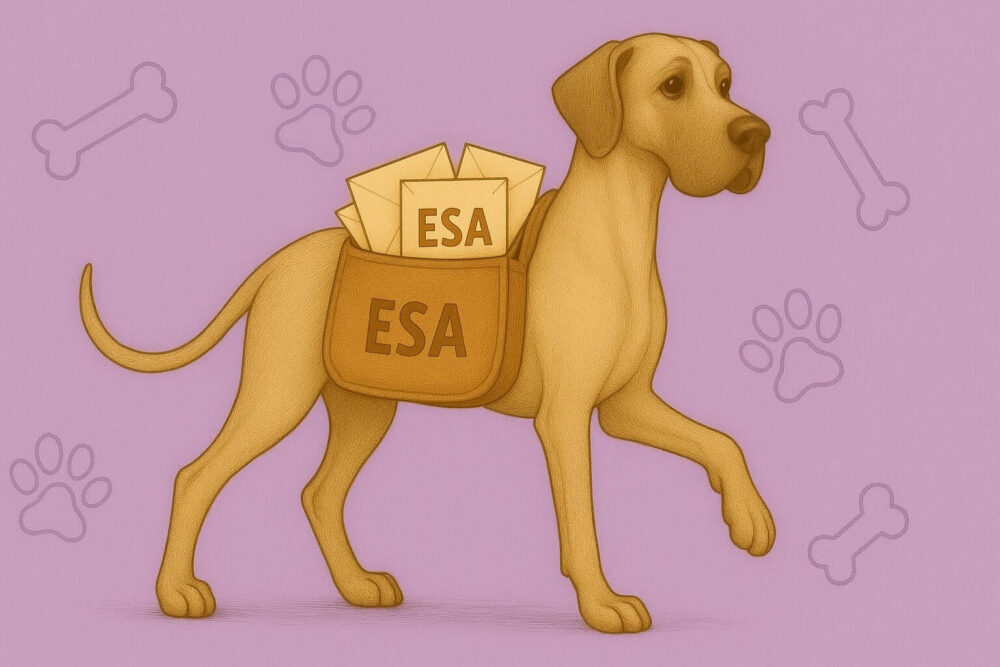
Table of Contents
Dogs are more than adorable goofballs with VIP access to your bed and snacks. Of the 45% of American households with these furry companions, a significant portion relies on them for emotional support, specialized disability assistance, or to help others ease anxiety in guided therapeutic sessions.
In this article, we’ll offer a comprehensive comparison of service dog vs. ESA vs. therapy dog, detailing their roles, access rights, and requirements. We’ll also outline the steps to getting an ESA letter.

Service Dog vs. Therapy Dog vs. Emotional Support Dog: What’s the Difference?
While service, therapy, and emotional support dogs help people with emotional or health issues, their specific roles, training, and rights are worlds apart. Here’s a quick rundown of their differences:
| Feature | Service Dog | Therapy Dog | Emotional Support Dog |
| Role | Offering specialized disability assistance | Providing comfort and companionship in different therapeutic settings | Providing comfort and companionship to the owner |
| Beneficiary | Person with a disability | Multiple people with mental or emotional conditions | Person with a mental or emotional condition (owner) |
| Prescription Needed | No | Yes | Yes |
| Legal Protections | Yes (FHA, ADA) | N/A | Yes (FHA) |
Emotional Support Dogs—Heartfelt Companions
Over 80% of American pet owners believe their furry friends bring them joy and emotional support. Dogs are no exception. While initially domesticated as work animals, they have gradually evolved into loyal companions, so much so that they’ve become man’s best friend.
Unlike other assistance animals, emotional support dogs do not need any specialized training. Their presence alone can help elevate your mood and reduce anxiety. All they have to do is show up, wag their tails, cuddle, or look at you like you’re holding a treat behind your back—boom, radiance activated!
Legal Protections of Emotional Support Dogs
According to the U.S. Department of Housing and Urban Development (HUD), emotional support animals (ESAs) are assistance animals that provide “therapeutic emotional support for individuals with disabilities.” For your dog to qualify as an ESA, a licensed mental health professional (LMHP) should issue you an ESA letter.
The letter acknowledges that an LMHP assessed your mental health and determined that you need an ESA. It typically doesn’t mention the specific emotional or mental condition to protect your medical records and prevent potential stigma or discrimination.
With this documentation, your dog enjoys the protection of the Fair Housing Act, giving you the right to:
- Live with them in any real estate or rental building, even if the landlord has a no-pet policy
- Avoid pet-related fees like cleaning charges and pet deposits that the landlord charges regular pet owners
- Live with the dog even if it does not meet the building’s breed and weight restrictions
When Can Your ESA Letter Be Rejected?
A landlord might deny your ESA access request or evict your dog if:
- It’s an owner-occupied building with four or fewer units
- The dog poses a significant financial or operational burden
- It’s a single-family home sold or rented directly by the owner (not through an agent)
- The dog poses a direct threat to other occupants’ safety and health
- The dog causes significant damage to the property
Some states also have additional guidelines regulating the application of this Act. For example, the Nuisance Animal Ordinance Act of Atlanta states that ESA owners may incur fines or face evictions if they fail to restrain their pets from “barking, meowing, whining, crowing, or making other sounds common to the species, persistently or continuously for a period of ten (10) minutes or longer.”

Service Dogs—The Elite Canines
The Americans with Disabilities Act defines a service dog as any dog individually trained to do work or perform tasks for the benefit of an individual with a disability. The training can begin when the dog is as young as six months and extend for 18–30 months.
While any type of dog can become a service animal with the proper training, certain breeds like Labrador retrievers, poodles, Pomeranians, boxers, Portuguese water dogs, and golden retrievers tend to be more reliable. And reasonably so—they exhibit higher intelligence, a calm demeanor, and a strong desire to work closely with humans.
From offering mobility assistance to retrieving items and opening doors, service dogs wear different collars. Their training is customized to each handler’s needs. Some common types of service dogs include:
| Type of Service Dog | Role |
| Guide dogs (seeing-eye dogs) | Helping visually impaired people navigate streets, obstacles, and public spaces |
| Hearing dogs | Alerting hearing-impaired people of sounds and signals in their environments |
| Allergy detection dogs | Detecting and informing their handlers about potential allergens in their food or environments |
| Medical alert dogs | Monitoring health indicators like blood sugar levels and alerting handlers about potential dangers |
| Psychiatric service dogs | Assisting individuals with mental health conditions navigate compromising environments like crowded places |
| Mobility assistance dogs | Retrieving items, opening and closing doors, offering balance support, and eliminating other barriers to the handler’s mobility |
| Autism service dogs | Helping individuals on the autism spectrum manage social interactions and calm down during agitating scenarios |
Legal Protections of Service Dogs
Besides the FHA, which guarantees them the same housing rights as ESAs, service dogs also enjoy public space access rights under the Americans with Disabilities Act (ADA) and the Airline Carrier Access Act (ACAA). According to these regulations, all service dogs are:
- Allowed to accompany their handlers in all public places, including stores, restaurants, schools, public transit, and hospitals
- Guaranteed housing access, even in real estate and rental apartments with no-pet policies
- Entitled to fly in the cabin with their handlers, provided they have the requisite DOT documentation
- Permitted in their handler’s workplace, as long as their presence doesn’t cause undue financial or operational challenges
- Exempt from paying pet-related fees in public places, housing units, and travel settings
- Safeguarded from documentation requirements in public places—businesses are only allowed to ask if they are service dogs and what tasks they are trained to perform
Therapy Dogs—Spreading Pawsitivity
Therapy dogs are the goodwill ambassadors of the canine world. Unlike service and emotional support dogs, they’re trained to assist multiple people, not just the handler. They offer emotional and psychological support to different people in hospitals, nursing homes, schools, disaster zones, and rehabilitation centers.
To join the therapy K9 force, a dog must be social, calm, and affectionate to strangers. They may also require basic training in providing comfort to people. These trainings do not come with certifications or access rights like ESAs and service dogs. As a result, therapy dogs are not protected by the FHA or ADA.
What Is the Difference Between an Emotional Support Dog and a Service Dog?
The main difference between emotional support dogs and service dogs is that the latter have specialized training to support people with disabilities with specific tasks. Emotional support dogs are often untrained; they rely on their natural prowess to provide comfort.
Another significant difference is that ESAs are not covered by the ADA, which guarantees service animals legal access to public places and facilities. Before the 2021 amendment of the Air Carrier Access Act, handlers of both emotional support dogs and service dogs enjoyed legal protection from paying extra fees during air travel. With the changes, only service dogs have this right.
As for the paperwork required for each, a service dog doesn’t need a certificate of training, and the HUD advises landlords against asking for any documentation regarding the dog’s status. Emotional support dogs, on the other hand, need the ESA letter to exercise their housing rights.

How To Get an ESA Letter for Your Emotional Support Dog (Without Getting Scammed)
The conventional process of obtaining an ESA letter can be pretty hectic:
- Find a licensed mental health professional authorized to practice in the state you’re seeking housing in
- Schedule an assessment appointment—some will insist on in-person consultations
- Get a diagnosis from the LMHP
- Obtain an ESA letter if you pass the assessment
If you’re trying to beat a deadline, this process might be too long and complicated. You might have to travel to the LMHP, which can be a significant inconvenience. With states like Louisiana requiring more than one consultation, fitting the commute time into your schedule can also be a hassle.
The online route also comes with potential drawbacks. The presence of a lot of misinformation on the internet regarding the processes, paperwork, and requirements of obtaining ESA letters doesn’t make things any better. This confusion can expose you to scammers who might entice you with “free” ESA letters, letter templates, guides, or certifications that are not valid documents.
Fortunately, you can avoid the confusion by working with a reputable ESA letter provider. For example, Your Service Animal streamlines the entire application into four simple steps.
5 Reasons You Should Apply for an ESA Letter Through Your Service Animal
With Your Service Animal, you don’t have to wait weeks to get your ESA letter. You also don’t have to visit a LMHP physically for an assessment. Here are five core reasons you should use this service:
- Fully remote process—The entire application and approval process happens online, helping you avoid undue commutes and long waiting hours
- Free online pre-qualification quiz—Before making any commitments, you take a free screening quiz to assess your ability to qualify for an ESA letter, saving you unnecessary effort if you don’t qualify
- Vetted LMHP—Your Service Animal connects you with a thoroughly screened LMHP in your state to ensure compliance
- Fast turnaround time—Once approved, Your Service Animal will send the ESA letter in 24–48 hours, which can be great when you have a tight deadline
- 100% money return—If the LMHP says you don’t qualify or the landlord rejects your ESA letter, you’re entitled to a full refund of your application fee
Get an ESA Letter ASAP
Avoid the hassle and confusion. Get your ESA letter through Your Service Animal in a few simple steps:
- Find out if you’re a good fit for an ESA letter with our online quiz
- Schedule an online appointment with a licensed mental health practitioner in your state
- Attend the online call and receive your ESA letter if clinically appropriate
- Receive a full refund if the therapist doesn’t issue an ESA letter or your landlord rejects your letter








